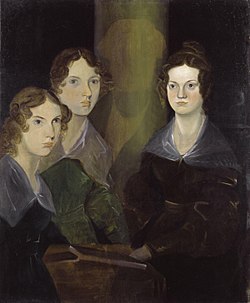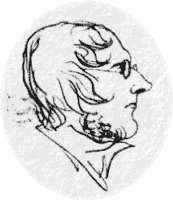
A | B | C | D | E | F | G | H | CH | I | J | K | L | M | N | O | P | Q | R | S | T | U | V | W | X | Y | Z | 0 | 1 | 2 | 3 | 4 | 5 | 6 | 7 | 8 | 9

National Portrait Gallery, London

The Brontës (/ˈbrɒntiz/) were a nineteenth-century literary family, born in the village of Thornton and later associated with the village of Haworth in the West Riding of Yorkshire, England. The sisters, Charlotte (1816–1855), Emily (1818–1848) and Anne (1820–1849), are well-known poets and novelists. Like many contemporary female writers, they published their poems and novels under male pseudonyms: Currer, Ellis, and Acton Bell. Their stories attracted attention for their passion and originality immediately following their publication. Charlotte's Jane Eyre was the first to know success, while Emily's Wuthering Heights, Anne's The Tenant of Wildfell Hall and other works were accepted as masterpieces of literature after their deaths.
The first Brontë children to be born to rector Patrick Brontë and his wife Maria were Maria (1814–1825) and Elizabeth (1815–1825), who both died at young ages due to disease. Charlotte, Emily and Anne were then born within a time period of approximately four years. These three sisters and their brother, Branwell (1817–1848), who had been born after Charlotte and before Emily, were very close to each other. As children, they developed their imaginations first through oral storytelling and play, set in an intricate imaginary world, and then through the collaborative writing of increasingly complex stories set in their fictional world. The deaths of their mother and two older sisters marked them and influenced their writing profoundly, as did their isolated upbringing. They were raised in a religious family.[1] The Brontë birthplace in Thornton is a place of pilgrimage and their later home, the parsonage at Haworth in Yorkshire, now the Brontë Parsonage Museum, has hundreds of thousands of visitors each year.
Origin of the name
The Brontë family can be traced to the Irish clan Ó Pronntaigh, which literally means "descendant of Pronntach". They were a family of hereditary scribes and literary men in Fermanagh. The version Ó Proinntigh, which was first given by Patrick Woulfe in his Sloinnte Gaedheal is Gall (transl. Surnames of the Gael and the Foreigner)[2] and reproduced without question by Edward MacLysaght, cannot be accepted as correct, as there were a number of well-known scribes with this name writing in Irish in the 17th and 18th centuries and all of them used the spelling Ó Pronntaigh. The name is derived from the word pronntach or bronntach,[3] which is related to the word bronnadh, meaning "giving" or "bestowal" (pronn is given as an Ulster version of bronn in O'Reilly's Irish English Dictionary.)[4] Patrick Woulfe suggested that it was derived from proinnteach (the refectory of a monastery).[2] Ó Pronntaigh was earlier anglicised as Prunty and sometimes Brunty.
At some point, Patrick Brontë (born Brunty), the sisters' father, decided on the alternative spelling with the diaeresis over the terminal ⟨e⟩ to indicate that the name has two syllables. Multiple theories exist to account for the change, including that he may have wished to hide his humble origins.[5] As a man of letters, he would have been familiar with classical Greek and may have chosen the name after the Greek βροντή (transl. thunder). One view, which biographer C. K. Shorter proposed in 1896, is that he adapted his name to associate himself with Admiral Horatio Nelson, who was also Duke of Bronte.[6] One might also find evidence for this theory in Patrick Brontë's desire to associate himself with the Duke of Wellington in his form of dress.
Family tree
| Hugh Brunty | Alice McClory | Anne Carne | Thomas Branwell | Jane Branwell | John Fennell | ||||||||||||||||||||||||||||||||||||||||||||||||||||||||||||||||||||||||||
| Patrick Brontë 1777–1861 | Maria Branwell 1783–1821 | Elizabeth Branwell 1776–1842 | Jane Branwell | John Kingston 1769–1824 | Jane Branwell Fennell 1791–1827 | William Morgan 1782–1858 | |||||||||||||||||||||||||||||||||||||||||||||||||||||||||||||||||||||||||
| Maria Brontë 1814–1825 | Elizabeth Brontë 1815–1825 | Arthur Bell Nicholls 1819–1906 | Charlotte Brontë 1816–1855 | Branwell Brontë 1817–1848 | Emily Brontë 1818–1848 | Anne Brontë 1820–1849 | |||||||||||||||||||||||||||||||||||||||||||||||||||||||||||||||||||||||||
Members of the Brontë family
Patrick Brontë

Patrick Brontë (17 March 1777 – 7 June 1861), the Brontë sisters' father, was born in Loughbrickland, County Down, Ireland, of a family of farm workers of moderate means.[5] His birth name was Patrick Prunty or Brunty. His mother, Alice McClory, was of the Roman Catholic faith, whilst his father Hugh was a Protestant, and Patrick was brought up in his father's faith.[7]

He was a bright young man and, after studying under the Rev. Thomas Tighe, won a scholarship to St John's College, Cambridge. There, he studied divinity, ancient history and modern history.[8] Attending Cambridge may have made him feel that his name was too Irish and he changed its spelling to Brontë (and its pronunciation accordingly), perhaps in honour of Horatio Nelson, whom Patrick admired.[9] It is more likely, however, that his brother William was 'on the run' from the authorities for his involvement with the radical United Irishmen, leading Patrick to distance himself from the name Brunty. Having obtained a Bachelor of Arts degree, he was ordained on 10 August 1806.[10] He is the author of Cottage Poems (1811), The Rural Minstrel (1814), numerous pamphlets, several newspaper articles and various rural poems.
In 1811, Patrick was appointed minister at Hartshead-cum-Clifton. In 1812, he met and married 29 year old Maria Branwell at Guiseley. In 1813, they moved to Clough House Hightown, Liversedge, West Riding of Yorkshire[11] and by 1820 they had moved into the parsonage at Haworth, where he took up the post of perpetual curate. (Haworth was an ancient chapelry in the large parish of Bradford, so he could not be rector or vicar.) They had six children.[12] On the death of his wife in 1821, his sister-in-law, Elizabeth Branwell, came from Penzance, Cornwall, to help him bring up the children. Open, intelligent, generous and dedicated to educating his children personally, he bought all the books and toys the children desired. He also accorded them great freedom and unconditional love, although he may have alienated them from the world due to his eccentric personal habits and peculiar theories of education.[clarification needed]

After several failed attempts to remarry, Patrick accepted permanent widowerhood at the age of 47, and spent his time visiting the sick and the poor, giving sermons and administering communion.[13] In so doing, he would often leave his children Maria, Elizabeth, Emily, Charlotte, Branwell and Anne alone with Elizabeth—Aunt Branwell and a maid, Tabitha Aykroyd (Tabby). Tabby helped relieve their possible boredom and loneliness especially by recounting local legends in her Yorkshire dialect as she tirelessly prepared the family's meals.[14] Eventually, Patrick would survive his entire family. Six years after Charlotte's death, he died in 1861 at the age of 84.[5] His son-in-law, the Rev. Arthur Bell Nicholls, would aid Mr Brontë at the end of his life as well.
Maria, née Branwell
Zdroj:https://en.wikipedia.org?pojem=BrontëText je dostupný za podmienok Creative Commons Attribution/Share-Alike License 3.0 Unported; prípadne za ďalších podmienok. Podrobnejšie informácie nájdete na stránke Podmienky použitia.
Antropológia
Aplikované vedy
Bibliometria
Dejiny vedy
Encyklopédie
Filozofia vedy
Forenzné vedy
Humanitné vedy
Knižničná veda
Kryogenika
Kryptológia
Kulturológia
Literárna veda
Medzidisciplinárne oblasti
Metódy kvantitatívnej analýzy
Metavedy
Metodika
Text je dostupný za podmienok Creative
Commons Attribution/Share-Alike License 3.0 Unported; prípadne za ďalších
podmienok.
Podrobnejšie informácie nájdete na stránke Podmienky
použitia.
www.astronomia.sk | www.biologia.sk | www.botanika.sk | www.dejiny.sk | www.economy.sk | www.elektrotechnika.sk | www.estetika.sk | www.farmakologia.sk | www.filozofia.sk | Fyzika | www.futurologia.sk | www.genetika.sk | www.chemia.sk | www.lingvistika.sk | www.politologia.sk | www.psychologia.sk | www.sexuologia.sk | www.sociologia.sk | www.veda.sk I www.zoologia.sk
